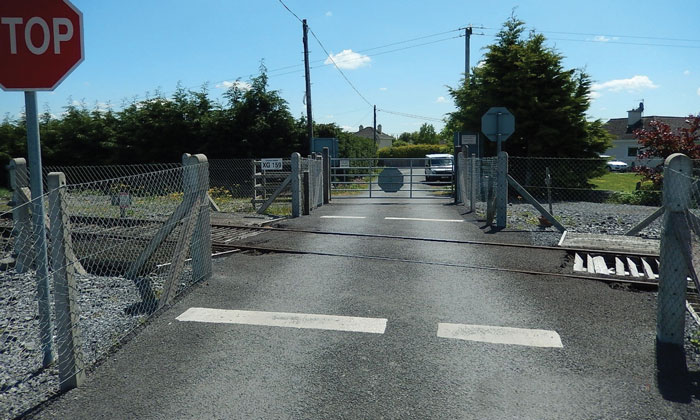Irish Rail’s strategy to improve safety of user worked level crossings
Posted: 25 May 2017 | Cathal Mangan | No comments yet
Cathal Mangan, Technical Manager at Irish Rail, discusses the risks of user worked level crossings and where the operator currently is in its 10-year Level Crossing Asset Strategy to manage this high-risk asset base, including actively meeting with level crossing users to inform them of safety procedures and monitoring the risks associated with each level crossing.


Level crossings, particularly user worked level crossings (those that require the user of the crossing to manually operate the gates and with no other system of control in place) continue to be the highest single infrastructural risk on the Irish Rail network. The largely rural environment of the network means that there is a proliferation of these crossings on both public and private roads as well as a considerable number of field-to-field crossings used predominantly for agricultural activities.
In 2013, in response to the ongoing risk posed by this high-risk asset category, Irish Rail developed a 10-year Level Crossing Asset Strategy with the objective of improving safety and reducing risk on level crossings by upgrading crossings, eliminating crossings and introducing technology, standardisation, education and enforcement.
The strategy is a multi-stranded approach, encompassing four key principles of level crossing safety across five key strategic areas. The strategy sought to provide a framework for Irish Rail to develop and implement meaningful work programmes aimed at improving level crossing safety, in particular at the key high risk category of user worked level crossings.
The core of the strategy is based on the adoption of the following five key strategic areas for improvement:
1. To develop and implement technological solutions at user worked level crossings
2. To implement targeted closures of level crossings on a cost-effective basis
3. To reduce the risk of collisions and nearmisses at level crossings
4. To improve the safety culture and aware ness both of internal and external stakeholders
5. To implement standardised approaches to level crossing types.
Progress to-date
As we approach the mid-point of the strategy, the proven reduction in total risk across the asset base shows its success and progress continues to be made across the strategic areas outlined at the outset. However, there are still challenges to be achieved as part of the strategy, which should achieve even greater reductions in risk.
The key project for the provision of warning light systems for level crossing users is currently being developed. The approval of the system is currently subject to authorisation for placing in service (APIS) as required under EU Directives. Based on typical unit costs and compared with the capital investment requirement for the broader solution, it is estimated that the total level of risk reduction that can be achieved via the implementation of low-cost technological solutions is 7-10 times that than would be achieved by targeting single or small numbers of crossings for capital investment. Roll out of initial systems is due to commence in 2017.
One of the primary success areas in the strategy to-date has been in the achievement of low value level crossing closures, which has significantly reduced risk. The process involved a root and branch review of every level crossing on a route-by-route basis and the selected targeting of land owners and local users with a view to developing opportunities for elimination of the crossing. While it has been an extremely labour-intensive process, the results have been very positive with 64 crossings closed since 2013.
The benefits of this cannot be understated and, while it may not be possible to sustain this rate of crossing eliminations due to the diminishing returns as a result of the achievements, it represents a significant success as part of the overall strategy. A central tenet to any strategy around level crossings should always be an ongoing programme that seeks to eliminate them outright and this strategy is no different in that regard.
A further element to the strategy to-date has been the comprehensive programmes of engagement with local users/user groups aimed at imparting a safety message.
The programme involves the development of information and targeting level crossing users with presentations at several level crossings on an annual basis. This visual presence at level crossings has been a positive component as it also presents opportunities for feedback to help us understand specific risks and concerns to further inform the on – going communications strategy and associated work programmes.
Representations have also been made throughout the country at appropriate forums, business premises and distribution centres as part of a comprehensive targeting of potentially vulnerable user groups. The work also involves attending local schools to further impart the key safety messages around level crossing use.
As well as local users, this strategy focusses on business users – for example, utilities companies, postal works, agricultural services providers and so on.
On a more broad and international level, Irish Rail has been a positive participant in the International Level Crossing Awareness Day (ILCAD), with a series of events programmed to coincide with this annual occurrence.
Overall, this comprehensive communications strategy continues to be undertaken annually with a specifically tailored programme of engagement developed for each year.
Understanding the risk
Central to the overall strategy is ensuring that there is a clear under – standing of the risks at each level crossing. Irish Rail operates a Level Crossing Risk Model (LCRM) which is a live tool for evaluating the ongoing risks at all level crossings. The LCRM requires the input of 120 characteristics for each level crossing which are determined based on a cyclic programme of inspections in line with Technical Standards. While the risk profile is constantly changing as crossing characteristics change, the LCRM is a key tool in allowing the identification of any intolerable risks as well as any evolving negative trends. The utilisation of the LCRM is important in ensuring that the application of resources is targeted in the appropriate areas where maximum benefit can be achieved.
An important component of the overall 10-year strategy has been the development of specific work programmes to ensure that the understanding of the risk profile at each crossing is accurate and up-todate. This is ensured by several means. For example, regular traffic counts are undertaken at relevant crossings, thus providing accurate, up-to-date information on level crossing usage – a key factor in the risk at any level crossing. This provides precise information on usage (and usage types) which is then used to regularly model the risk profile, as well as an overview of changing trends at level crossings, thus allowing for opportunities to tailor strategies in line with the changing risk profile.
The technology for undertaking these surveys is relatively inexpensive and easily distinguishes different vehicle types, while a camera system is deployed for capturing pedestrian usage across the level crossings. This type of work is supplemented by annual inspections and detailed surveys of crossings which further help to inform the risk model. The regular collection of information is a key component in maintaining the model, and therefore keeping the risk profile relevant.
Further works to be achieved
Each of the strategy’s work strands will continue into the second half of the programme, while several other initiatives are also set to be introduced.
An example of a particular risk contributor is ‘skewed’ level crossings where the angle of the road to the rail is other than 90 degrees. There are a wide range of these across the Irish Rail network and a dedicated programme for removal, where possible, of these is to be developed. Skewed level crossings can present a particular risk to users at user worked crossings depending on the extent and local conditions.
As an improvement in the overall economic and railway investment situation begins to tentatively materialise, detailed plans are being developed to provide project-ready designs for the elimination of some of the highest risk crossings. Ongoing closures in the meantime will continue to be sought across the rail network.
The measure of success of the overall strategy will continue to be the cumulative reduction of level crossing risk.
The achievements to-date are encouraging but these must now be underpinned by equal or better risk reductions in the second half of the 10-year level crossing strategy.
Biography





